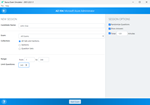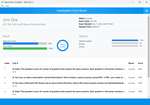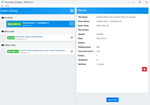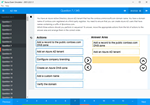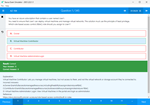Download Oracle Database 12c: Advanced PL-SQL.1z0-148.PracticeDumps.2018-02-15.75q.tqb
| Vendor: | Oracle |
| Exam Code: | 1z0-148 |
| Exam Name: | Oracle Database 12c: Advanced PL/SQL |
| Date: | Feb 15, 2018 |
| File Size: | 5 MB |
How to open TQB files?
Files with TQB (Taurus Question Bank) extension can be opened by Taurus Exam Studio.
Purchase
Coupon: TAURUSSIM_20OFF
Discount: 20%
Demo Questions
Question 1
The STUDENTS table exists in your schema.
Examine the DECLARE section of a PL/SQL block:

Which two blocks are valid?
- BEGINOPEN cursor3 FOR SELECT * FROM students;cursor1 :=cursor3;END;
- BEGINOPEN stcur;cursor1 :=stcur;END;
- BEGINOPEN cursor1 FOR SELECT * FROM students;stcur :=cursor1;END;
- BEGINOPEN stcur;cursor3 :=stcur;END;
- BEGINOPEN cursor1 FOR SELECT * FROM students;cursor2 :=cursor1;END;
Correct answer: DE
Question 2
Examine the code:

Which two subprograms will be created successfully?
- CREATE FUNCTION p4 (y pkg.tab_typ) RETURN pkg.tab_typ ISBEGINEXECUTE IMMEDIATE ‘SELECT pdt_id, pdt_name FROM TABLE (:b)’BULT COLLECT INTO pkg.x USING y;RETURN pkg.x;END p4;
- CREATE PROCEDURE p1 (y IN OUT pkg.tab_typ) ISBEGINEXECUTE IMMEDIATE ‘SELECT f (:b) FROM DUAL’ INTO y USING pkg.x;END p1;
- CREATE PROCEDURE p2 (v IN OUT VARCHAR2) ISBEGINEXECUTE IMMEDIATE ‘SELECT f (:b) FROM DUAL’ INTO v USING pkg.x;END p2;
- CREATE FUNCTION p3 RETURN pkg. tab_typ ISBEGINEXECUTE IMMEDIATE ‘SELECT f (:b) FROM DUAL’ INTO pkg.x;END p3;
- CREATE PROCEDURE p5 (y pkg. rec_typ) ISBEGINEXECUTE IMMEDIATE ‘SELECT pdt_name FROM TABLE (:b)’ BULK COLLECT INTO y USING pkg.x;END p5;
Correct answer: AC
Question 3
Examine the section of code taken from a PL/SQL program:

PLSQL_OPTIMIZE_LEVEL PARAMETER is set to 3.
Which two statements are true?
- Calls to TESTPROC will always be inlined as it is compiled with PLSQL_OPTIMIZE_LEVEL=3.
- Calls to TESTPROC are never inlined in both lines commented as Call1 and Call 2.
- Calls to TESTPROC are not inlined in the line commented as Call 1.
- Calls to TESTPROC are inlined in both lines commented as Call 1 and Call 2.
- Calls to TESTPROC might be inlined in the line commented as Call 2.
Correct answer: AE
Explanation:
Reference: https://docs.oracle.com/cd/E18283_01/appdev.112/e17126/tuning.htm Reference: https://docs.oracle.com/cd/E18283_01/appdev.112/e17126/tuning.htm
Question 4
Which statement is true about the DBMS_PARALLEL_EXECUTE package?
- DBMS_PARALLEL_EXECUTE is a SYS-owned package and can be accessed only by a user with DBA privileges.
- To execute chunks in parallel, users must have CREATE JOB system privilege.
- No specific system privileges are required to create or run parallel execution tasks.
- Only DBAs can create or run parallel execution tasks.
- Users with CREATE TASK privilege can create or run parallel execution tasks.
Correct answer: B
Explanation:
Reference https://docs.oracle.com/cd/E11882_01/appdev.112/e40758/d_parallel_ex.htm#ARPLS67331 (security model) Reference https://docs.oracle.com/cd/E11882_01/appdev.112/e40758/d_parallel_ex.htm#ARPLS67331 (security model)
Question 5
Which two statements are true regarding edition-based redefinition (EBR)?
- There is no default edition defined in the database.
- EBR does not let you upgrade the database components of an application while in use.
- You never use EBR to copy the database objects and redefine the copied objects in isolation.
- Editions are non-schema objects.
- When you change an editioned object, all of its dependents remain valid.
- Tables are not editionable objects.
Correct answer: EF
Explanation:
Reference: https://docs.oracle.com/cd/E11882_01/appdev.112/e41502/adfns_editions.htm#BABEHGAF Reference: https://docs.oracle.com/cd/E11882_01/appdev.112/e41502/adfns_editions.htm#BABEHGAF
Question 6
Which two blocks of code execute successfully?
- DECLARESUBTYPE new_one IS BINARY_INTERGER RANGE 0..9;my_val new_one;BEGINmy_val :=0;END;
- DECLARESUBTYPE new_string IS VARCHAR2 (5) NOT NULL;my_str_new_string;BEGINmy_str := ‘abc’;END;
- DECLARESUBTYPE new_one IS NUMBER (2, 1);my_val new_one;BEGINmy_val :=12.5;END;
- DECLARESUBTYPE new_one IS INTEGER RANGE 1..10 NOT NULL;my_val new_one;BEGINmy_val :=2;END;
- DECLARESUBTYPE new_one IS NUMBER (1, 0);my_val new_one;BEGINmy_val := -1;END;
Correct answer: AD
Question 7
Which statement is correct about DBMS_LOB.SETOPTIONS and DBMS_LOB.GETOPTIONS for SecureFiles?
- DBMS_LOB.GETOPTIONS can only be used for BLOB data types.
- DBMS_LOB.SETOPTIONS can perform operations on individual SecureFiles but not an entire column.
- DBMS_LOB. SETOPTIONS can set option types COMPRESS, DUPLICATE, and ENCRYPT.
- If a table was not created with compression specified in the store as securefile clause then DBMS_LOB.SETOPTIONS can be used to enable it later.
Correct answer: D
Explanation:
Reference: https://docs.oracle.com/cd/E11882_01/appdev.112/e18294/adlob_smart.htm Reference: https://docs.oracle.com/cd/E11882_01/appdev.112/e18294/adlob_smart.htm
Question 8
You are designing and developing a complex database application built using many dynamic SQL statements. Which option could expose your code to SQL injection attacks?
- Using bind variables instead of directly concatenating parameters into dynamic SQL statements
- Using automated tools to generate code
- Not validating parameters which are concatenated into dynamic SQL statements
- Validating parameters before concatenating them into dynamic SQL statements
- Having excess database privileges
Correct answer: A
Explanation:
Reference: https://docs.oracle.com/database/121/LNPLS/dynamic.htm#LNPLS645 Reference: https://docs.oracle.com/database/121/LNPLS/dynamic.htm#LNPLS645
Question 9
Examine this code executed as SYS:

Examine this code executed as SPIDER and the error message received upon execution:

What is the reason for this error?
- The procedure needs to be granted the DYNAMIC_TABLE_ROLE role.
- The EXECUTE IMMEDIATE clause is not supported with roles.
- Privileges granted through roles are never in effect when running definer’s rights procedures.
- The user SPIDER needs to be granted the CREATE TABLE privilege and the procedure needs to be granted the DYNAMIC_TABLE_ROLE.
Correct answer: C
Question 10
Which codes executes successfully?
- CREATE PACKAGE pkg ASTYPE rec_typ IS RECORD (price NUMBER, inc_pct NUMBER);PROCEDURE calc_price (price_rec IN OUT rec_typ);END pkg;/CREATE PACAKGE BODY pkg ASPROCEDURE calc_price (price_rec IN OUT rec_typ) ASBEGINprice_rec.price := price_rec.price + (price_rec.price * price_rec.inc_pct)/100;END calc_price;END pkg;/DECLARE1_rec pkg. rec_typ;BEGIN1_rec_price :=100;1_rec.inc_pct :=50;EXECUTE IMMEDIATE ‘BEGIN pkg. calc_price (:rec); END;’ USING IN OUT 1_rec;END;
- CREATE PACKAGE pkg ASTYPE rec_typ IS RECORD (price NUMBER, inc_pct NUMBER);END pkg;/CREATE PROCEDURE calc_price (price_rec IN OUT pkg. rec_typ) ASBEGINprice_rec.price := price_rec.price + (price_rec.price * price_rec.inc_pct)/100;END/DECLARE1_rec pkg.rec_typ;BEGINEXECUTE IMMEDIATE ‘BEGIN calc_price (:rec); END;’ USING IN OUT 1_rec (100, 50);END;
- CREATE PACKAGE pkg ASTYPE rec_typ IS RECORD (price NUMBER, inc_pct NUMBER);END pkg;/CREATE PROCEDURE calc_price (price_rec IN OUT pkg. rec_typ) ASBEGINprice_rec.price := price_rec.price + (price_rec.price * price_rec.inc_pct)/100;END ;/DECLARE1_rec pkg. rec_typ;BEGIN1_rec_price :=100;1_rec.inc_pct :=50;EXECUTE IMMEDIATE ‘BEGIN calc_price (1_rec); END;’;END;
- DECLARETYPE rec_typ IS RECORD (price NUMBER, inc_pct NUMBER);1_rec rec-typ;PROCEDURE calc_price (price_rec IN OUT rec_typ) ASBEGINprice_rec.price := price-rec.price+ (price_rec.price * price_rec.inc_pct)/100;END;BEGIN1_rec_price :=100;1_rec.inc_pct :=50;EXECUTE IMMEDIATE ‘BEGIN calc_price (:rec); END;’ USING IN OUT 1_rec;END;
Correct answer: B
HOW TO OPEN VCE FILES
Use VCE Exam Simulator to open VCE files

HOW TO OPEN VCEX FILES
Use ProfExam Simulator to open VCEX files


ProfExam at a 20% markdown
You have the opportunity to purchase ProfExam at a 20% reduced price
Get Now!